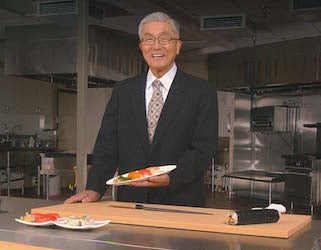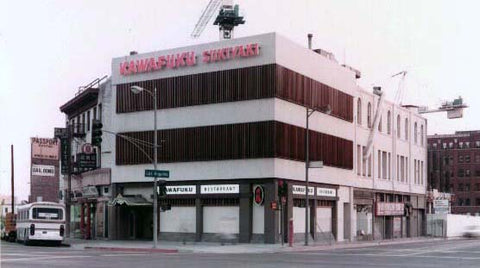From Farm to Home & Restaurant: Food Waste Facts
Food waste has serious implications for public health and the environment. Learn the facts on food waste, a...

If asked to identify the figure behind the American sushi craze in a police lineup, you’d pass right over Harry Goldberg, a Jewish entrepreneur from Chicago. But Goldberg, along with his friend Noritoshi Kanai, a lanky Japanese immigrant, was part of one of the most underrated odd couples in the history of American cuisine…
If asked to identify the figure behind the American sushi craze in a police lineup, you’d pass right over Harry Goldberg, a Jewish entrepreneur from Chicago.
But Goldberg, along with his friend Noritoshi Kanai, a lanky Japanese immigrant, was part of one of the most underrated odd couples in the history of American cuisine. Fewer people still would recognize their names in Japan, and neither of these men were famous sushi chefs, but they somehow brought the first sushi bar to the United States.
This created a revolution.
The unlikely tip of the spear of this revolution? The California Roll. It wasn’t their invention, but it was a side-effect of their actions. More on its creator shortly.
The California Roll can be thought of as a culinary Trojan Horse. It was made with rice on the outside of the seaweed, and it contained avocado instead of the traditional fatty tuna—both of which are distinctly non-Japanese additions. These comforting manipulations (or bastardizations, if you’re a purist) are the reason why you don’t think of sushi in the same way you do Soylent Green, or the monkey brain soup from Indiana Jones and the Temple of Doom. The California Roll is the Spaghetti Bolognese of sushi. Or perhaps think of it as what Chicken Tikka Masala (created in Scotland, many claim) is to Indian cuisine. They’re famous signature dishes—gateway drugs to a cuisine—despite the fact that none of them are popular in their supposed motherlands.
How did two sushi rogues initiate this revolution?
And how did Ronald Reagan—not someone usually associated with the word “progressive”—become a walking advertisement for this strange foreign delicacy? Well, it’s one hell of a story, that changed the course of sushi history.
We begin when Noritoshi Kanai arrives in the United States in 1964 with nothing to his name except a small family and a history of entrepreneurial failures.

He did, however, have a job lined up as the President of Mutual Trading Company, a fledgling importer of rare Japanese delicacies (interestingly, the same company to bring edamame to America). While attending a trade conference in Chicago, Kanai met Harry Goldberg, an outgoing and gregarious smooth-talker, one of those guys who was just born to sell. Goldberg convinced Kanai to hire him as an MTC representative on the spot.
Together, they began making frequent trips to Asia to look for new foods that might appeal to the American palate. While in Japan, Kanai took Goldberg to a sushi bar and introduced him to Edomae sushi (what we now call nigiri, or plain raw fish on rice). Goldberg was hooked. He went back to the same place every single day until the pair left Japan.
With MTC struggling, Goldberg believed that sushi might be the product to turn the tide and establish the company as a massive player in the United States. He convinced Kanai to proposition a friend, Tokijiro Nakajima, who owned a tiny seven-seat restaurant in the heart of Los Angeles’ Little Tokyo district call Kawafuku. Nakajima declined the idea, thinking the two men were crazy.
But Kanai was a hustler, and he wouldn’t drop the idea. After a few months of constant nagging, Nakajima finally relented.

Kawafuku subsequently became the first restaurant in America to serve Edomae sushi, catering to Japanese businessmen who longed for the elegant simplicity of the food they were raised on. They quickly turned their American colleagues onto the place, which was soon packed at all hours of the day. The venture was so successful that the original chef made over $30,000 in the first four years, considered a small fortune in those times.
Other sushi restaurants started popping up around Little Tokyo. When a chef named Ichiro Mashita at Tokyo Kaiken Restaurant couldn’t land any fresh tuna, he used the closest approximation he could find: California avocado. He mixed the avocado with crabmeat and christened it the California Roll.
By 1968, sushi was spreading out of the Little Tokyo district into some of the nicest neighborhoods in the city. The opening of Osho on Pico Boulevard put a sushi restaurant within walking distance of the 20th Century Fox studio lot, so close that the movie stars could almost smell the cooking rice. The joint was expensive and exclusive, with only thirty seats, and word began to spread. So many sushi bars opened in Santa Monica that Wilshire Boulevard, one of the main drags, became known as “Sushi Row.”
The most obvious breakout moment came in 1985, when President Reagan hosted the Japanese Prime Minister for dinner. Guess what they ate?
Between 1988 and 1998, the number of sushi restaurants in the United States quadrupled. There are at least 10,000 sushi restaurants in America now, with the number growing 28% between 2010 and 2014.
Here at Exo, we’ve closely studied the rise of sushi. Why? Because our challenge with insect protein is essentially the same.
Sushi took many decades to reach its current ubiquity, but we think we can do the same within five years, thanks to a few factors.
Some of these factors include mainstream interest in diet and nutrition (Paleo, gluten-free), the “real/natural food” movement (Whole Foods’ domination, anti-GMO fury), foodie fervor (Top Chef, seven hour Cronut lines), and awareness of environmental impact.
Insect protein also has a whole lot more going for it than raw fish did—crickets contain more calcium than milk and more iron than beef gram for gram. Plus, the resource savings are enormous: crickets produce 80 times less methane than cows, and require 20 times less resources to raise overall.
Raw fish rose to prominence on a wave of avocado and rice. Now imagine where crickets can go with a little chocolate.
+++